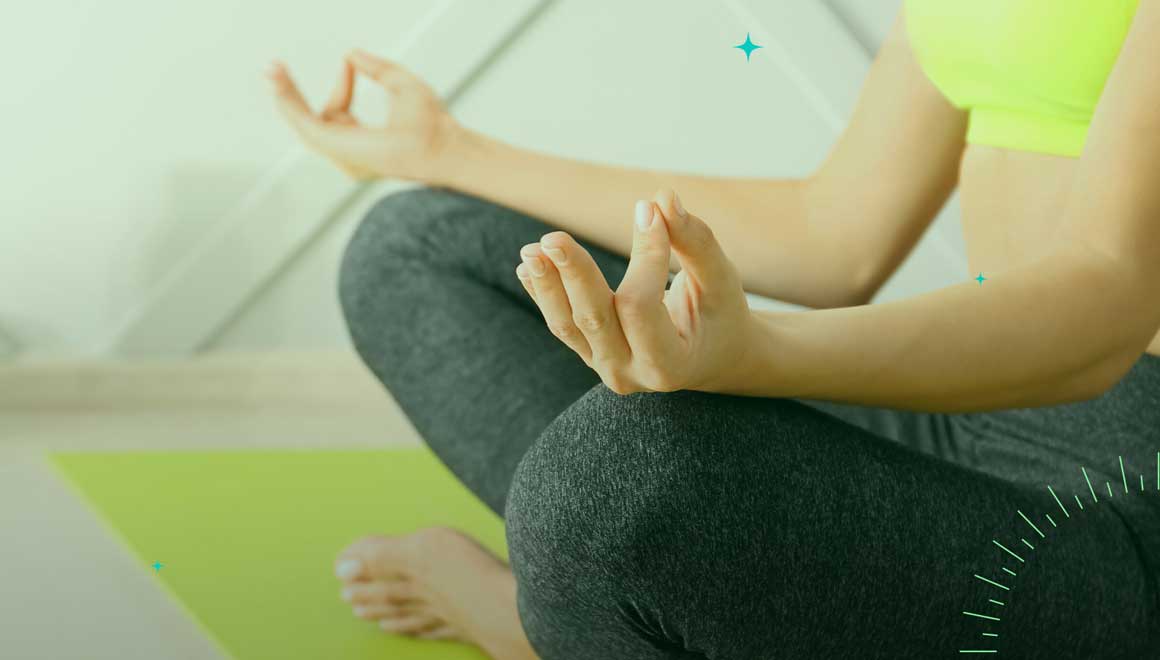Athletes work and train hard for long hours, often pushing their bodies to its limit.
Workouts force our bodies to respond, adapt, and improve. The greater the intensity of the exercise, the more stress it generates, and the more our bodies change for the better.
However, many people forget that the stress from strenuous exercise isn’t only physical – it’s also mental.
Mental stress depletes athletes of their drive and their focus, ultimately leading to low satisfaction and poor overall performance, thus defeating the purpose of training in the first place.
One way to reduce mental stress and exhaustion (while also improving overall physical performance) is through sports meditation and mental training for athletes.
Defining Sports Meditation
Sports meditation is a form of mindfulness and mental training that is aimed specifically at helping athletes and active individuals with performance in mind.
Sports meditation is a simple yet effective way to help athletes be more mindful, increase their focus, reduce stress, and improve their mind-body connection.
Meditation has been practiced for centuries and in several different cultures. Today, meditation is considered a form of complementary medicine that focuses on the mind and body to achieve mental fitness.
Practicing meditation allows us to turn our attention inwards and focus on our thoughts and mental headspace. It offers us a chance to work through jumbled thoughts and eliminate what’s taking space in our minds and causing stress.
Moreover, it helps us increase our self-awareness, manage sources of anxiety, and reduce negative emotions.
In recent years, exciting new possibilities have emerged from the intermingling of meditation with modern technology.
The immersive qualities of virtual reality, for example, have amplified the effectiveness of meditation sessions for users, while additional neurofeedback technology is revealing new ways to treat meditation like training.
How Sports Meditation Helps Athletes
As mental health draws further into the focus of society at large, more and more athletes are realizing how the benefits of consistent meditation can apply to them.
Meditation helps users achieve greater focus, states of relaxation, an inner sense of calm, and more attuned mindfulness. Meditating before or after a workout, for example, can contribute to a stronger sense of focus and drive, or even help the post-workout recovery period.
Researchers noted that practicing mindfulness meditation and training the mind may help mitigate or reduce the negative effects of taxing workouts and training on their emotions and way of thinking.
Another study found that short bouts of meditation after grueling training sessions offer large benefits for athletes. Over four weeks, athletes who took part in 12-minute mindfulness meditation sessions after their training showed better mental resilience, attention or focus, and mood levels.
Relaxation-focused meditation, during which participants mainly listened to calming music and systematically relaxed their muscles, is also beneficial. The study showed it helped athletes be less likely to have declining moods.
Data also suggests that the long-term benefits of meditation also helps athletes achieve better sports performance. It does this by bringing down their sport-anxiety levels, reducing repetitive negative thoughts, and enhancing the frequency of the flow state.
What’s even more exciting for athletes looking to implement meditation into their routines are the myriad of ways to leverage the newer technology we mentioned earlier.
Athletes who use our app Healium, for example, benefit from brainwave training by utilizing neurofeedback during their meditation sessions.
By analyzing the raw brainwave data from your own body and tracking your progress over time, you can remove the mystery from meditation and begin treating your meditation sessions the same way you would a typical workout.
The Different Brain States Helped by Meditation
Did you know you have different brain or mental states?
Brain states play a key role in determining our level of focus on our tasks or activities. One of the ways we can categorize these brain states is by looking at our brainwaves.
Brainwaves are the result of the neurons in our brain communicating and producing small electrical currents. There are five different brainwaves, which in turn affect our state of consciousness.
Three relevant brainwave states for athletes are the alpha, beta, and theta states. Increasing both the alpha and theta brainwave activity introduces our brain into a new, yet similar state: the flow state.
What is the Flow State?
The flow state of mind describes a mental state where we are completely focused on one task or activity. All our attention goes into what we are currently doing.
In layman’s terms, this is described as being “in the zone”, and while it may seem like a myth, we’re here to tell you it’s very real!
The ability to intensely focus alone makes the flow state important for athletes who need to focus on their training; however, research shows that those are not the only potential benefits of the flow state for athletes.
According to a study by Frontiers in Psychology, our brain exhibits greater theta and alpha activities when in the flow state. This means athletes in the flow can potentially reap the benefits of both alpha and theta brainwave states.
As such, the benefits of the flow state include:
- Better emotional regulation
- Increased levels of happiness and satisfaction
- Increased engagement with the task at hand
- Greater intrinsic motivation and enjoyment
- Improved physical performance
- Better physical recovery and sleep
- Uninhibited creativity
- Out-of-the-box problem solving
- Better learning and skill mastery
How to Trigger Your Flow State
We typically enter the flow state unintentionally or unconsciously. Considering all the benefits of being in the flow state though, it is advantageous to know how to induce it when we want or need it.
This is where meditation for athletes comes into play. Since the flow state is connected to increased alpha and theta brainwave activity, meditation and training the brain can help us reach the flow state.
According to a Journal of Neuroscience study, mindfulness meditation can help unlock alpha brainwave states, thereby greatly increasing our chances of getting into the flow.
Practicing mindfulness sports meditation and entering the flow state before a grueling athletic training or workout session lets us maximize our time and energy. Aside from aiding in improving athletic performance, it can also reduce the negative mental effects of exercise-induced stress and pessimism.
Despite all the benefits, it is also crucial to understand that it is not always possible to put ourselves into a flow mental state. Rather than a tried and true method, meditation is more about creating the right circumstances and inducing our mind to enter the flow state.
The Best Meditation Styles for Athletes
Mindfulness for Athletes
If we want to learn how to meditate for athletes, it is first important to learn about the different ways to practice meditation. Exploring and familiarizing ourselves with various meditation styles can help us find the optimal sports meditation practice to use.
Mindfulness meditation is a type of meditation that is based on increasing attention to the here and now. It focuses on gaining greater executive control and enabling intentional actions and decisions.
Mindfulness meditation involves paying close attention to our breathing and expanding our awareness outward.
Practicing mindfulness sports meditation is usually done while sitting down, closing our eyes, and paying attention to our breathing.
Focus Meditation for Athletes
Focus meditation for athletes typically involves an exercise in maintaining concentration on a single thing.
For example, focusing on specific body patterns (like breathing), sounds in your environment, or visuals helps train your brain to “drift off” less often. You’ll also become more aware of your mind in general, and recognize those moments you begin to lose concentration in the first place.
This style of meditation improves focus, memory, and decreases mind wandering–all of which can be extremely beneficial for athletes, whether they’re looking for a performance boost on gameday or need help with the mental aspect of training for their particular sport.
Quiet Mind Meditation for Athletes
Quiet mind meditations enhance your awareness of your “self” and minimizes your internal “self-talk”, which grants ample room for more regenerative thoughts towards yourself.
With how pivotal a role self-confidence and pure, uninterrupted states of mind can be when it comes to sports performance, athletes understand how beneficial simply turning off your brain can be perhaps more than most.
Mindful Movement: Yoga and Martial Arts
We can also practice mindfulness sports meditation in other ways. Qi gong, tai chi, and yoga are popular physical activities that complement mindfulness meditation.
Qi gong and tai chi are Chinese martial arts that combine breathing exercises, balance, gentle physical movement, and more. Meanwhile, yoga is a series of postures that require controlled breathing.
Practicing any of these three together with mindful sports meditation is ideal for both pre-and post-workout meditation. Before workouts, it can help athletes warm-up. Afterward, it can help them cool down and relax their muscles.
Is Meditation Used in Professional Sports?
There are plenty of professional athletes that practice sports meditation.
Among famous athletes, basketball players Lebron James and Michael Jordan, as well as tennis player Novak Djokovic are vocal supporters of sports meditation.
The late Kobe Bryant is another athlete who was well-known for advocating the importance of meditation for sports success.
The benefits of mental training for athletes were highlighted in a study involving a group of elite National Collegiate Athletic Association (NCAA) Division I football players. Even with just a minimum of 12 minutes per day, mindfulness sports meditation helped the young football players maintain their focus, keep their moods up, and fortify their mental resilience.
Treating Meditation like Training
Meditation for sports success is not exactly a new concept. However, it has grown increasingly popular in recent years, thanks to well-known athletes who practice and advocate for it.
The growing number of free and easy-to-use meditation apps today also contributes to the wider practice of sports meditation.
Accessibility to guided meditation apps opens the path toward daily meditation for athletes. It makes it easier to incorporate the practice into athletes' daily workout regimen and treat it as part of their training.
Apps like Healium take the art of meditation to the next level by not only immersing the user in AR and VR experiences, but also by supplementing the benefits of meditation with data from neurofeedback so that athletes can tackle their meditation practice like they would any other form of training.

